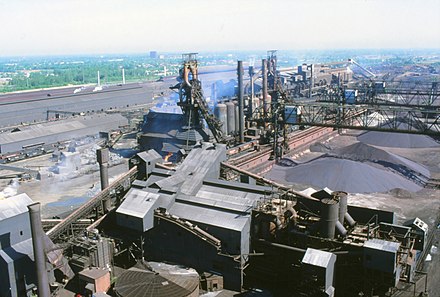While we are putting this page together, please feel free to view our “notes” below.

McLouth began in Detroit in 1934. They started building their Trenton Mill in 1948, and the Gibraltar works in 1954. From the 1950s thru the 1970s it employed 5,000 workers at what was the top industry wage at the time.
However, cracks began to show toward the end of the 1970s, as overseas and non-union steelmakers began making inroads Downriver, as they were doing to firms such as Bethlehem Steel in Pennsylvania.
At the start of the 1980s, payroll had been trimmed from 5,000, but was still solid at 3,775 – still very soluable.
Management began asking for concessions as early as September 1980, they asked for a one year wage freeze.
The employees responded with a 3 day strike.
Five months later (February 1981), having realized a $56 million loss for the company, management asked for a 2-year freeze for cost-of-living adjustments.
The employees said no.
In December 1981, the company defaulted on $166 million in loans and were forced to file Chapter 11 bankruptcy for the first time. The union then almost immediately accepted $14 million in concessions, plus a ten percent wage cut for non-union workers.
Then came the shocking news in November 1982: Outside investor Cyrus Tang purchases the firm for $465 million. A total of 162 additional jobs would be cut as part of a six-year contract that would require more employee givebacks. By this time the company’s official name was changed to McLouth Steel Products Co.
Profits were turned in 1983, but by 1987 debt resurfaced in a big way: $250 million. By now, the workforce was down to 2,000 unionized and 400 non-unionized, almost 40% loss from the start of the decade.
Cyrus Tang vanished from the scene as negotiations continued over the next two years – which resulted in another $85 million loss, but control of the company was basically in the hands of the employees, at least symbolically: the new official name would be “McLouth Steel: An Employee Owned Company.”
The struggles would continue though, but offers for help at the state level were there. Governor John Engler appointed a blue-ribbon committee, was able to award McLouth $5 million, and set them on a partnership with Thyssen Steel (later Thyssen-Krupp). The partnership only lasted a year before McLouth decided to come up with their own in-house solution.
By September 1995, the troubles continued to loom. Workforce numbers were halved to 1,200 unionized and 150 non-unionized. Assets were $136 million, Liabilities were $360 million. This would result in a second Chapter 11 filing.
“McLouth’s dead… it’s bankrupt… I’ll use a little elbow grease and clean that place up… I saw two hundred guys, and maybe twenty were working. One hundred and eighty were doing nothing but moaning and groaning, and some were asleep. You’ve got to change that.”
– MAURICE TAYLOR
asked about his interest in purchasing McLouth (undated)
MORE NOTES TO COME, COVERING THE TIMER PERIOD 1995-2009.